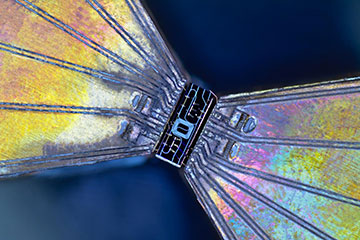
Researchers in the U.K. have built a new integrated circuit to implement measurement-device-independent quantum key distribution, particularly suited to city-wide data networks. [Image: Henry Semenenko, University of Bristol]
Quantum computers promise to carry out certain tasks far faster than classical machines, and as such pose a threat—the possibility that they could factorize the huge numbers that currently keep emails, bank transactions and other online operations secure.
But it now looks like another quantum technology—cryptography—should be able to neutralize that threat. New research shows how integrated photonics could enable quantum key distribution (QKD) using small, robust and relatively cheap semiconductor chips (Optica, doi: 10.1364/OPTICA.379679).
QKD explained
QKD involves two people—conventionally known as Alice and Bob—sharing a secret string of bits to encrypt and decrypt messages. Alice encodes the digits using the states of a series of quantum particles that she sends to Bob, who measures the particles. Alice then tells Bob over an open classical channel which bases she used to prepare the states, and Bob keeps only those bits that he obtained using the same bases.
By then publicly comparing a subset of those digits—which constitutes the key—the two can establish whether an eavesdropper (Eve) has been trying to intercept the quantum information. That’s because Eve’s measurements would be seen as errors in the key.
Although uncrackable in principle, QKD is in practice vulnerable to attacks. By exploiting imperfections in the equipment used to establish the key, hackers can create “side channels” to siphon off the secret information without revealing their presence. In particular, they can blind Bob’s detector using strong pulses of light so that it works like a classical device, rather than a quantum one.
Introducing Charlie
The latest research shows how microchips can be used to make the photon sources needed in a scheme devised to combat attacks against detectors known as measurement-device-independent QKD.
Rather than Alice sending a series of quantum particles to Bob, both instead send independent bit strings to a third, untrusted party (known as Charlie). With the incoming particles arriving in step, Charlie knows when Alice and Bob’s states are correlated because they interfere destructively to produce a click in his detector. When Charlie then communicates this information, Bob can infer the state of Alice’s bits directly from his.
Again, by comparing a part of the key publicly, Alice and Bob can ascertain whether or not the third party (Charlie) has been lying. But this time they can do so without Bob having to detect any particles. It is Charlie who has the detector, but because that device doesn’t reveal anything about the secret key it is immune to side channels or other attacks.
Toward city-wide QKD networks
Henry Semenenko and colleagues at the University of Bristol in the U.K. have made Alice and Bob’s photon sources from 6×2-mm indium phosphide chips that contain a series of Mach-Zehnder interferometers and other optical components. The researchers sent weak pulses of photons down a fiber link whose length they represented using a variable attenuator. They encoded signals using photons’ time of arrival and phase, and detected those signals using superconducting nanowire single-photon devices.
Doing so, the researchers were able to transmit information with a quantum bit error rate of less than 0.5%. They found that they could send a secret key at about 1 kilobit per second over 100 km of simulated fiber, but saw that this rate dropped to just 1.25 bits per second over 200 km. They believe that the system should still provide positive key rates at distances of at least 350 km.
The researchers conclude that indium phosphide provides a “feasible platform” for QKD networks, with mass production yielding “relatively cost-effective devices.” They say that, in the future, such devices should allow households to connect to the Internet using quantum encryption, with QKD particularly suited to city-wide networks. Banks of detectors, made possible by advances in superconducting technology, could be used to increase data rates, they add.
Once they have developed application-specific hardware, at some point before the end of 2024, the researchers plan to test their technology using Bristol’s city-wide fiber network.
